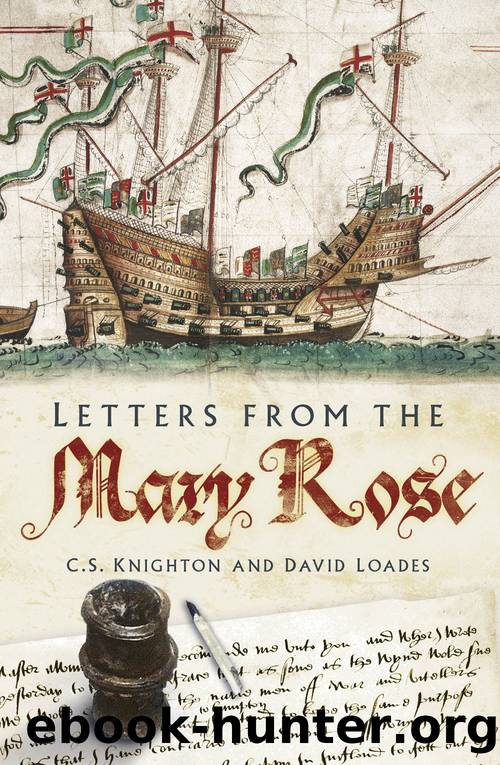Letters From the Mary Rose by David Loades & C S Knighton

Author:David Loades & C S Knighton [Loades, David & Knighton, C S]
Language: eng
Format: epub
Tags: History, Maritime History & Piracy, Literary Collections, Letters, Military, Naval, Europe, Great Britain, General, Renaissance, Transportation, Ships & Shipbuilding
ISBN: 9781803990743
Google: SONdEAAAQBAJ
Publisher: The History Press
Published: 2022-06-23T20:32:25+00:00
5
THE WAR OF 1522â25
Commentary
The peace between England and France which had been signed in 1514 lasted precariously for nearly eight years. It had been sealed by a marriage between Henryâs younger sister, Mary, and Louis XII. But Louis died in December of the same year, worn out, it was said, by his energetic young wife. The new King was Francis I; he was much the same age as Henry, and shared many of the same tastes and characteristics. However, he sought his military reputation in Italy, and did not break the peace in the north. Henry toyed with the idea of a new French war in both 1516 and 1517, but drew back on each occasion. Meanwhile, his chief minister and Lord Chancellor, Thomas Wolsey, was trying to shape an Anglo-French entente as part of a general European peace settlement. In 1518 he succeeded, and Tournai (Henryâs conquest from the war of 1512â14) was returned to France under the terms of the Treaty of London. This ambitious treaty, which temporarily raised the reputations of both Henry and Wolsey to dizzy heights, was intended to be permanent, but lasted in fact only some three years. Ferdinand of Aragon (de facto King of all Spain), Henryâs father-in-law, had died in 1516 and had been succeeded by his grandson, Charles of Ghent. Charles was also the grandson of the Emperor Maximilian, and in 1519 Maximilian died in turn. His son Philip having died in 1506, Charles was elected to succeed him, thus creating an empire of unprecedented dimensions. Charles now ruled, under various titles, the Holy Roman Empire (including most of northern Italy), Spain (including most of southern Italy) and the Low Countries. These domains virtually surrounded France, and a renewal of a Franco-Imperial war was therefore only a matter of time. For obvious reasons, both sides wanted Henryâs support, and it was with that in mind that Henry and Francis staged their famous âsummit conferenceâ at the Field of the Cloth of Gold in 1520, an exercise in competitive display which caused Henry to parade his full credentials as a âsea kingâ.
The meeting failed, largely because the competitive display strained goodwill to breaking point, and in September 1521 Henry entered into an agreement with the new Emperor, for a joint attack on France in the following year. When Charles visited England to confirm their treaty, Henry met him at Dover, where the two monarchs inspected the fleet and went aboard the Henry Grace à Dieu and the Mary Rose (46). By the terms of the agreement, however, although England was bound to declare war on France in May 1522, Henry was not pledged to a major land campaign until the following year. The first campaign in the summer of 1522 was therefore fought at sea. In spite of this, Henry made no attempt to augment his existing fleet, and this must raise some doubts about how seriously he was proposing to take his commitments. In 1512 there had been a considerable build-up,
Download
This site does not store any files on its server. We only index and link to content provided by other sites. Please contact the content providers to delete copyright contents if any and email us, we'll remove relevant links or contents immediately.
The Radium Girls by Kate Moore(11592)
100 Deadly Skills by Clint Emerson(4674)
The Templars by Dan Jones(4549)
Rise and Kill First by Ronen Bergman(4538)
The Doomsday Machine by Daniel Ellsberg(4234)
The Rape of Nanking by Iris Chang(4005)
Killing England by Bill O'Reilly(3893)
Hitler in Los Angeles by Steven J. Ross(3790)
Stalin by Stephen Kotkin(3715)
12 Strong by Doug Stanton(3409)
Hitler's Monsters by Eric Kurlander(3148)
Blood and Sand by Alex Von Tunzelmann(3045)
Darkest Hour by Anthony McCarten(3011)
The Code Book by Simon Singh(2840)
The Art of War Visualized by Jessica Hagy(2826)
Hitler's Flying Saucers: A Guide to German Flying Discs of the Second World War by Stevens Henry(2618)
Babylon's Ark by Lawrence Anthony(2422)
The Second World Wars by Victor Davis Hanson(2416)
Tobruk by Peter Fitzsimons(2369)
